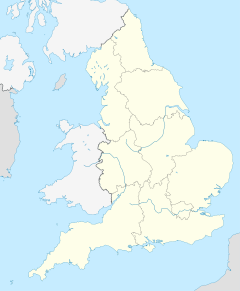Wells
| Wells | ||
|---|---|---|
| Wells Cathedral | ||
| Coordinates | 51 ° 12 ′ N , 2 ° 39 ′ W | |
|
|
||
| Residents | 10,536 | |
| surface | 5.48 km² (2.12 mi² ) | |
| Population density: | 1923 inhabitants per km² | |
| administration | ||
| Post town | WELLS | |
| ZIP code section | BA5 | |
| prefix | 01749 | |
| Part of the country | England | |
| region | South West England | |
| Website: http://www.wells.gov.uk/ | ||
Wells is a town located 27 km south of Bristol in Somerset , south-west England , Great Britain , at the south foot of the Mendip Hills . With around 10,000 inhabitants, Wells is the second smallest cathedral city in England after the City of London and belongs to the Mendip district .
history
Already in Roman times there was a settlement on the site of today's Wells. Its location was well suited for the establishment of a town, as there are many springs that gave the city its name. It was not until the Anglo-Saxon period that Wells became more important as an important city in the Kingdom of Wessex . King Ine founded a church here in 704. When the old bishopric of Sherborne was divided in 909, Wells became the seat of the new bishopric of Wells ; this caused the city to grow. However, Bishop John de Villula moved the seat of his diocese to Bath in 1090 . As a result, there were arguments between the Canons of Wells and the monks of Bath. In 1245 the parish was finally named Diocese of Bath and Wells , and its bishop was to be elected by clergymen from both cities.
Bishop Robert granted Wells a charter in 1160, by which the citizens were exempt from certain customs duties. Other charters given by Bishops Reginald Fitz Jocelin before 1180 and Savaric FitzGeldewin around 1201 gave Wells residents the right of jurisdiction in disputes within their own ranks. These privileges were confirmed by King John in 1201 , as well as by Eduard I in 1290, by Eduard III. with the granting of further privileges in 1334, 1341, 1343 and 1345, from Richard II. 1377, from Heinrich IV. 1399 and from Heinrich VI. 1424. Wells also received a certificate of incorporation from Queen Elizabeth I in 1589, which freed the city from episcopal control, and other such documents followed in 1683, 1688 and 1835. Wells was represented in Parliament from 1295 to 1868.
Before 1160, the city received permission to hold fairs on March 3, October 14 and November 30, to which in 1201 the additional market days of May 9, June 25 and November 25 were added. In the Middle Ages, these fairs were important for urban cloth sales. Later, silk, stocking, glove and other industries took the place of the cloth trade. In the early 19th century, paper and brush production emerged as the dominant branches of industry.
Attractions
Wells has a medieval townscape with many houses, inns and city gates dating from the 14th to 16th centuries. Notable buildings are mainly:
- The Cathedral of Wells was built in the years 1182-1260. The west facade is equipped with over 300 statues. Three scissor arches are a special architectural feature . The cathedral gives Wells city rights , since in England every settlement that has a cathedral can automatically call itself a city.
- In the immediate vicinity of the cathedral is the medieval Vicar's Close from the 14th century, the first row house settlement in Great Britain and the oldest continuously inhabited street in Europe.
- Also in the old town is the Bishop's Palace, built by Bishop Jocelin from 1210 on a square floor plan, which is partly only preserved as a ruin. In the garden of the palace, which is surrounded by a moat, are the springs that gave the place its name.
- The parish church of Saint Cuthbert was originally an early English cross-shaped building of the 13th century, the appearance of which changed significantly in the 15th century when it was redesigned in the Perpendicular style . In 1561 the church lost its centrally built tower, which was replaced by the current tower that rises above the west gate.
- Wells Cathedral School
Town twinning
Wells has city partnerships with Paray-le-Monial in France, Bad Dürkheim in Germany and Fontanellato in Italy.
Personalities
- Edgar Wright (born 1974), director
- Thomas Linley senior (1733–1795), musician and stage composer
- Alexander Edmund Batson Davie (1847-1889), Canadian politician

